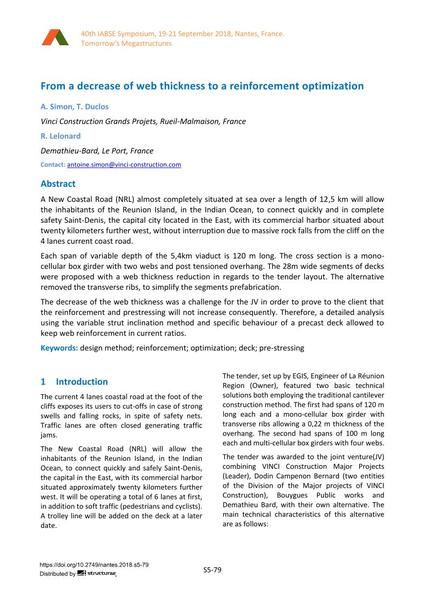From a decrease of web thickness to a reinforcement optimization

|
|
|||||||||||
Bibliographic Details
| Author(s): |
A. Simon
(Vinci Construction Grands Projets, Rueil-Malmaison, France)
T. Duclos (Vinci Construction Grands Projets, Rueil-Malmaison, France) R. Lelonard (Demathieu-Bard, Le Port, France) |
||||
|---|---|---|---|---|---|
| Medium: | conference paper | ||||
| Language(s): | English | ||||
| Conference: | IABSE Symposium: Tomorrow’s Megastructures, Nantes, France, 19-21 September 2018 | ||||
| Published in: | IABSE Symposium Nantes 2018 | ||||
|
|||||
| Page(s): | S5-79 | ||||
| Total no. of pages: | 7 | ||||
| DOI: | 10.2749/nantes.2018.s5-79 | ||||
| Abstract: |
A New Coastal Road (NRL) almost completely situated at sea over a length of 12,5 km will allow the inhabitants of the Reunion Island, in the Indian Ocean, to connect quickly and in complete safety Saint-Denis, the capital city located in the East, with its commercial harbor situated about twenty kilometers further west, without interruption due to massive rock falls from the cliff on the 4 lanes current coast road. Each span of variable depth of the 5,4km viaduct is 120 m long. The cross section is a mono- cellular box girder with two webs and post tensioned overhang. The 28m wide segments of decks were proposed with a web thickness reduction in regards to the tender layout. The alternative removed the transverse ribs, to simplify the segments prefabrication. The decrease of the web thickness was a challenge for the JV in order to prove to the client that the reinforcement and prestressing will not increase consequently. Therefore, a detailed analysis using the variable strut inclination method and specific behaviour of a precast deck allowed to keep web reinforcement in current ratios. |
||||
| Keywords: |
optimization deck reinforcement Reinforcing design method pre-stressing
|
||||
